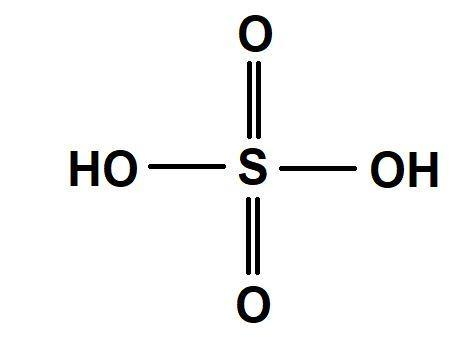
The number of dative bonds in sulphuric acid molecule is:
(A) $0$
(B) $1$
(C) $2$
(D) $4$
Answer
224.4k+ views
Hint: Dative bond is another name for coordinate bond. It is also a type of covalent bond in which both the electrons are donated by one atom at another, unlike an ordinary covalent bond where there is mutual sharing. Each of the atoms brings an electron to form a bond.
Complete Step by Step Solution:
Sulphuric acid, also called as oil of vitriol has chemical formula\[{H_2}S{O_4}\]. Sulphur has a very high affinity for oxygen. The tendency of pπ−dπ bonding increases which increases the back bonding tendency as we move along the period from carbon to chlorine. Thus, from carbon to chlorine the formation of double bonds with oxygen tendency increases. Hence, sulphur has a very tendency to form pi bonds with oxygen.(before carbon the elements do not show covalent bonding).
Pi bond between sulphur and oxygen releases more energy and leads to more stability than a single bond between $S$ and $O$. Thus, when drawing the structure of sulphuric acid first priority is given to double bond with oxygen.

This double bond is actually back bonding which is a dative bond. Thus, there are $2$ dative bonds in sulphuric acid.
Hence, The correct answer is C.
Note: Sometimes, a dative bond is misunderstood as an ionic bond because the atom accepting the electron is represented by negative charge while donation of electron by the atom bears negative charge. sulphuric acid has zero charge on it but it is a charged molecule due to the electronegativity difference between \[S\]and\[O\]. The molecule has sp3 hybridization and it is tetrahedral in shape.
Complete Step by Step Solution:
Sulphuric acid, also called as oil of vitriol has chemical formula\[{H_2}S{O_4}\]. Sulphur has a very high affinity for oxygen. The tendency of pπ−dπ bonding increases which increases the back bonding tendency as we move along the period from carbon to chlorine. Thus, from carbon to chlorine the formation of double bonds with oxygen tendency increases. Hence, sulphur has a very tendency to form pi bonds with oxygen.(before carbon the elements do not show covalent bonding).
Pi bond between sulphur and oxygen releases more energy and leads to more stability than a single bond between $S$ and $O$. Thus, when drawing the structure of sulphuric acid first priority is given to double bond with oxygen.

This double bond is actually back bonding which is a dative bond. Thus, there are $2$ dative bonds in sulphuric acid.
Hence, The correct answer is C.
Note: Sometimes, a dative bond is misunderstood as an ionic bond because the atom accepting the electron is represented by negative charge while donation of electron by the atom bears negative charge. sulphuric acid has zero charge on it but it is a charged molecule due to the electronegativity difference between \[S\]and\[O\]. The molecule has sp3 hybridization and it is tetrahedral in shape.
Recently Updated Pages
JEE Main 2026 Session 1 Correction Window Started: Check Dates, Edit Link & Fees

JEE Isolation, Preparation and Properties of Non-metals Important Concepts and Tips for Exam Preparation

Isoelectronic Definition in Chemistry: Meaning, Examples & Trends

Ionisation Energy and Ionisation Potential Explained

Iodoform Reactions - Important Concepts and Tips for JEE

Introduction to Dimensions: Understanding the Basics

Trending doubts
JEE Main 2026: City Intimation Slip and Exam Dates Released, Application Form Closed, Syllabus & Eligibility

JEE Main 2026 Application Login: Direct Link, Registration, Form Fill, and Steps

Understanding the Angle of Deviation in a Prism

How to Convert a Galvanometer into an Ammeter or Voltmeter

Hybridisation in Chemistry – Concept, Types & Applications

Ideal and Non-Ideal Solutions Explained for Class 12 Chemistry

Other Pages
JEE Advanced Marks vs Ranks 2025: Understanding Category-wise Qualifying Marks and Previous Year Cut-offs

Thermodynamics Class 11 Chemistry Chapter 5 CBSE Notes - 2025-26

Organic Chemistry Some Basic Principles And Techniques Class 11 Chemistry Chapter 8 CBSE Notes - 2025-26

JEE Advanced 2026 - Exam Date (Released), Syllabus, Registration, Eligibility, Preparation, and More

JEE Advanced 2026 - Exam Date (Released), Syllabus, Registration, Eligibility, Preparation, and More

Hydrocarbons Class 11 Chemistry Chapter 9 CBSE Notes - 2025-26




